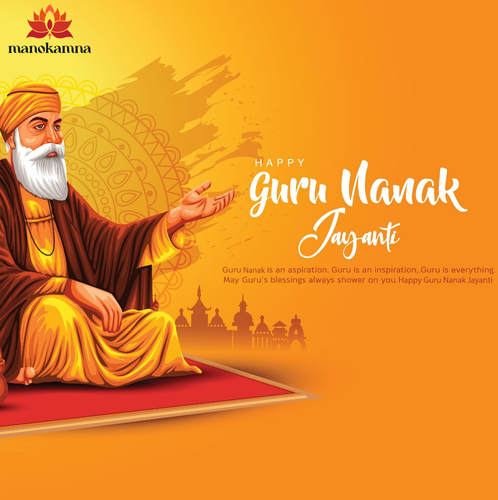
Guru Nanak Jayanti, also known as Gurpurab, is one of the most significant and widely celebrated festivals in Sikhism. This festival marks the birth of Guru Nanak Dev Ji, the founder of Sikhism, who is regarded as the first of the ten Sikh Gurus. Guru Nanak Jayanti is celebrated with great enthusiasm by millions of people, particularly in India and countries with a significant Sikh population. It usually falls in the month of Kartika (October-November), according to the lunar calendar, and is celebrated on the full moon day of the month.
In this article, we will explore the historical and spiritual significance of Guru Nanak Jayanti, the ways it is celebrated, and its deep-rooted cultural importance.
Who Was Guru Nanak Dev Ji?
Guru Nanak Dev Ji was born in 1469 CE in the village of Rai Bhoi Ki Talwandi, now known as Nankana Sahib, in present-day Pakistan. From a young age, Guru Nanak displayed deep spiritual wisdom and a strong connection to the Divine. His teachings emphasized the oneness of God, equality of all people, and the importance of living a life of selfless service, humility, and devotion.
Guru Nanak’s message was revolutionary for his time. He rejected the caste system, ritualistic practices, and religious dogma, advocating for a simple, truthful, and compassionate life. His philosophy was encapsulated in three fundamental principles:
- Naam Japna – Recite God’s name and meditate on Him.
- Kirat Karni – Earn an honest living through hard work and dedication.
- Vand Chakna – Share your wealth and resources with others, especially those in need.
Guru Nanak’s teachings led to the creation of the Sikh religion, which promotes universal brotherhood, peace, and equality.
Guru Nanak Jayanti Celebrations
Guru Nanak Jayanti is celebrated by Sikhs around the world with immense devotion and joy. The celebrations typically last for several days, starting with the recitation of sacred hymns from the Guru Granth Sahib, the holy scripture of Sikhism.
1. Prabhat Pheri (Early Morning Processions)
The day begins with Prabhat Pheri, an early morning procession led by Sikhs carrying the Nishan Sahib, the Sikh flag. Devotees sing devotional hymns, particularly the Jaap Sahib, Aarti, and other compositions of Guru Nanak, along the streets. This procession is a symbol of Guru Nanak’s teachings, spreading the light of spirituality and peace.
2. Akhand Path (Continuous Reading of the Guru Granth Sahib)
During Guru Nanak Jayanti, an Akhand Path is organized in Gurudwaras (Sikh temples) across the world. This is a continuous, uninterrupted reading of the Guru Granth Sahib from start to finish, often conducted for 48 hours or more. The reading is accompanied by Kirtan (devotional singing) and Simran (meditative chanting of God’s name). It is believed that this spiritual practice purifies the mind and soul, bringing the community together in devotion.
3. Langar (Community Meal)
One of the most unique and revered traditions of Guru Nanak Jayanti is the Langar, a free community kitchen where people from all walks of life, regardless of their background or social status, are served food. The concept of Langar was introduced by Guru Nanak Dev Ji to teach equality, selflessness, and the importance of sharing. It is a manifestation of Guru Nanak’s teachings of Vand Chakna.
Langar is prepared by volunteers and served to everyone without any discrimination. The act of serving Langar, whether cooking, cleaning, or distributing food, is considered an essential part of the celebration and reflects Guru Nanak’s message of service to humanity.
4. Nagar Kirtan (Procession with Music)
Another hallmark of Guru Nanak Jayanti is the Nagar Kirtan, a grand procession where Sikh devotees carry the Guru Granth Sahib on a beautifully decorated float. The procession is accompanied by Kirtan (the singing of devotional hymns), Gatka (traditional Sikh martial arts), and Shabad Kirtan (spiritual singing). The procession moves through the streets, spreading Guru Nanak’s message of love, peace, and equality to the community.
The Nagar Kirtan serves as a joyful, colorful reminder of the teachings of Guru Nanak and is often marked by celebrations of music, dance, and spiritual reflection.
5. Gurdwara Visits and Worship
On the day of Guru Nanak Jayanti, devotees flock to Gurdwaras, the Sikh places of worship, to offer prayers and pay their respects. Sikhs begin the day by participating in the morning Nitnem, which includes the recitation of the morning prayers, followed by Ardas, a prayer of gratitude and request for blessings. Devotees also listen to the Katha (spiritual discourse) and participate in Kirtan throughout the day.
The Gurdwaras are beautifully decorated with flowers and lights, and the atmosphere is filled with spiritual energy and devotion.
Spiritual Significance of Guru Nanak Jayanti
Guru Nanak Jayanti is more than just a celebration of the birth of Guru Nanak Dev Ji. It is an opportunity to reflect on his life’s teachings and apply them to one’s own life. The day serves as a reminder to:
- Embrace the Oneness of God: Guru Nanak’s teachings emphasize the importance of worshiping the one true God, who is omnipresent, omnipotent, and formless. Sikhs believe that God transcends all religions and forms and can be experienced through devotion and service.
- Live a Life of Truth and Service: Guru Nanak taught that true happiness comes from living a life of honesty, integrity, and selfless service. Sikhs are encouraged to perform honest work, avoid materialism, and share their wealth with those in need.
- Practice Equality and Brotherhood: Guru Nanak rejected the caste system and any form of discrimination. He emphasized that all humans, regardless of their social, economic, or religious background, are equal in the eyes of God. Sikhs strive to uphold these values of equality and brotherhood in their daily lives.
- Follow the Path of Compassion: Guru Nanak’s message was always one of love, compassion, and peace. He taught that it is through love and understanding that we can overcome hatred, division, and intolerance in society.
Guru Nanak Jayanti Around the World
Guru Nanak Jayanti is celebrated globally by Sikhs, not only in India but also in countries with significant Sikh populations such as the United States, the United Kingdom, Canada, and Australia. Major Gurdwaras in these regions host celebrations, including Akhand Path, Nagar Kirtans, Langars, and Kirtan Darbars, where people gather to sing hymns and share meals together.
In places like Amritsar, the birth city of Guru Nanak, the Golden Temple becomes the focal point of celebrations. The temple is beautifully illuminated with lights, and large crowds of devotees come to seek blessings and participate in the festivities. The celebration in Nankana Sahib (Pakistan), Guru Nanak’s birthplace, is also a major event, with pilgrims traveling from across the world to pay homage.
